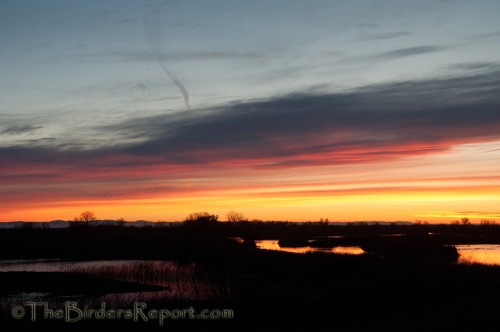 Sunrise over Sacramento National Wildlife Refuge photos by Larry Jordan
Sunrise over Sacramento National Wildlife Refuge photos by Larry Jordan
Last weekend I reserved a photo blind (hide as it’s called across the pond) and got some pretty good photographs and also counted birds for the Great Backyard Bird Count 2011 (see previous post).
There are two blinds at the Sacramento National Wildlife Refuge (NWR) and one each at Delevan NWR and Colusa NWR. The blinds are all of similar size and functionality as you can see on their blind description webpage. Blind #1 is pictured above (click on all photos for full sized images).
According to their website, the “Sacramento National Wildlife Refuge Complex consists of five national wildlife refuges (NWR) and three wildlife management areas (WMA) that comprise over 35,000 acres of wetlands and uplands in the Sacramento Valley of California. In addition, there are over 30,000 acres of conservation easements in the Complex. The Refuges and easements are part of the U.S. Fish and Wildlife Service; they serve as resting and feeding areas for nearly half the migratory birds on the Pacific Flyway.”
I believe them when they say that nearly half of the migratory birds on the flyway visit the refuge. Here’s a photo of probably 30 or 40 acres chock full of Snow Geese (Chen caerulescens) that I probably underestimated on my GBBC as 6,500 birds. What do you think?
I was able to find a few “Blue Geese” or dark morph Snow Geese as well as the white morph shown here.
The reddish brown off-color of the head feathers is due to the stains the feathers acquire after digging through the mud for long periods of time
I saw hundreds of Greater White-fronted Geese (Anser albifrons) and probably underestimated their numbers also.
Then there were the ducks. I don’t know about you, but I find it a bit challenging to identify female ducks. A birding buddy of mine gave me a hint on how to ID females when I asked him he said, “just take a look at the male she’s hanging around with.” This is great advise this time of year when they are pairing up.
Here are some couples, starting with the more obvious Northern Shoveler (Anas clypeata) drake and his mate
Followed be the ever present Northern Pintail (Anas acuta).
There were several Gadwall (Anas strepera)
And a few American Wigeon (Anas americana)
You can see in-flight photos of these ducks in this older post.
There were several hundred American White Pelicans (Pelicanus erythrorhynchos) flushed from one of the ponds, some of them circling around and lighting back in the pond and some that took a different path and flew close enough for me to practice my in-flight digiscoping skills. This was the best in-flight shot I had this day with the scope.
My favorite shots from the blind however, were the Tree Swallows (Tachycineta bicolor) that visited the snag you see in the photo of the blind above.
I had a group of Tree Swallows visit this snag on my first visit to this blind back in March of 2009 (you can see some of those images on this flickr page). They exhibited the same behavior that appeared to be mock fighting or pairing behavior. This photo shows two birds with mouths agape, one stationary on the snag and the other flying in.
This is many times followed by what would appear to be a food exchange if it were an adult feeding young. I am inclined to think it is some kind of pairing behavior but I have found nothing in the literature on this behavior. If anyone knows what this might be, please enlighten us all by leaving a comment.
Leaving the blind for the auto tour around noon, I took a few more photos while completing my trip.
There is a Snowy Egret (Egretta thula) that can sometimes be found at the far end of the auto loop, just before you turn back to head to the visitor center. There is a dam on the creek there that seems to be a good place to catch fish.
Here is a video of the bird catching a fish from the creek
You can always find raptors in the cottonwoods on the edges of the refuge and this day was no exception. After all, what would a day of birding be without seeing a raptor?
I took some shots of this juvenile Red-tailed Hawk (Buteo jamaicensis) as it looked over the refuge.
Finally, on the way out, a truck stopped in front of me and was looking down a long stretch of grass along the irrigation canal by the road. I looked to my left to see two Ring-necked Pheasants (Phasianus colchicus) chasing each other up and down this pathway. The pheasants scared up an American Bittern that was in the canal but I was unable to get my lens on it before it dove back into the bulrush.
I did get some photos of the Ring-necked Pheasants though, as they engaged in what appeared to be a cock fight. I’m not sure if it was real or play (I’m thinking play), but they put on a great show.
The Sacramento National Wildlife Refuge, and the entire refuge system, has got to be one of the premiere places in California to bird in the late fall, winter and spring. If you visit California when the refuge is flooded, you are sure to see a myriad of avifauna.
I hope you enjoyed this brief trip through the refuge. To see more birds, check out Bird Photography Weekly and World Bird Wednesday!

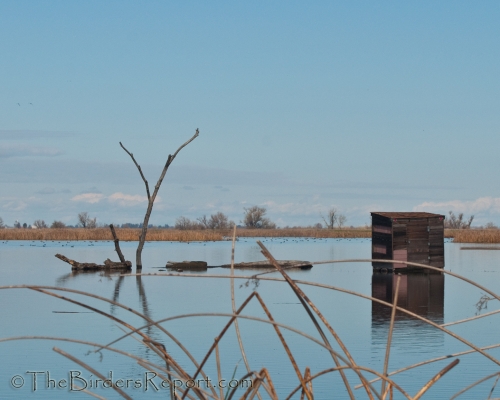

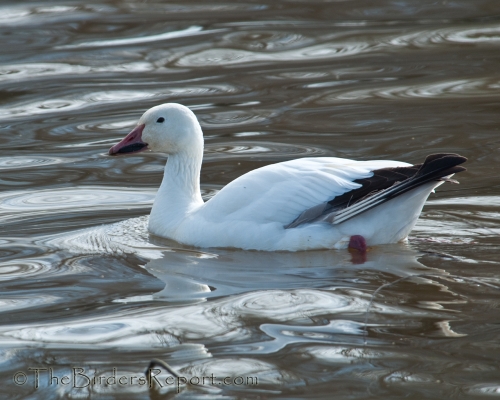

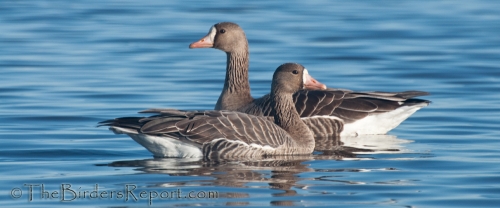
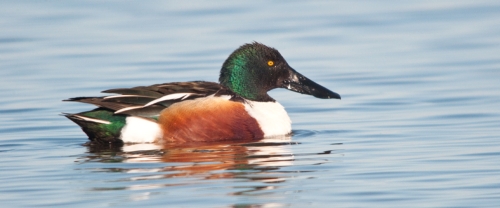
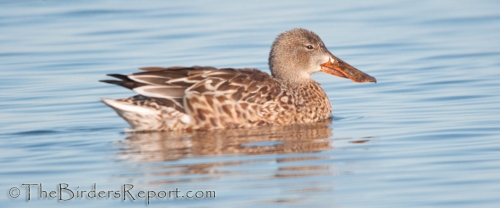
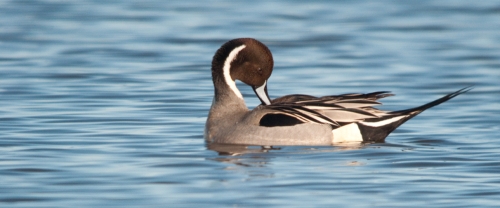
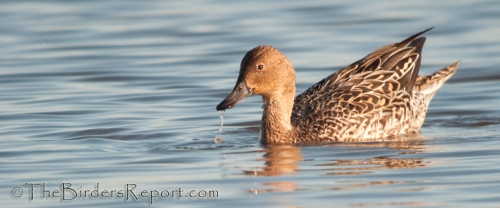
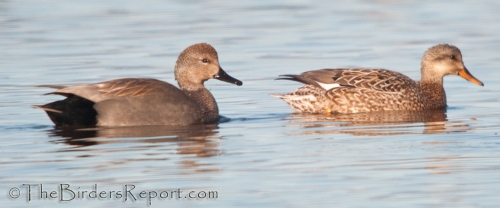
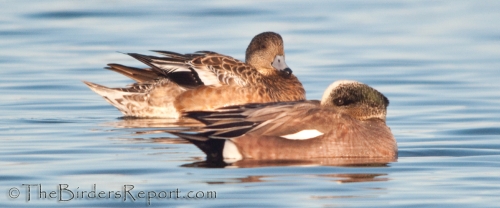
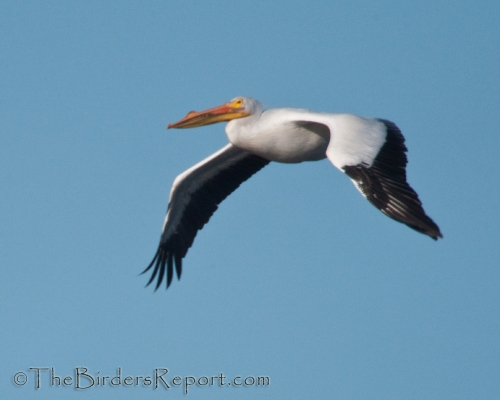
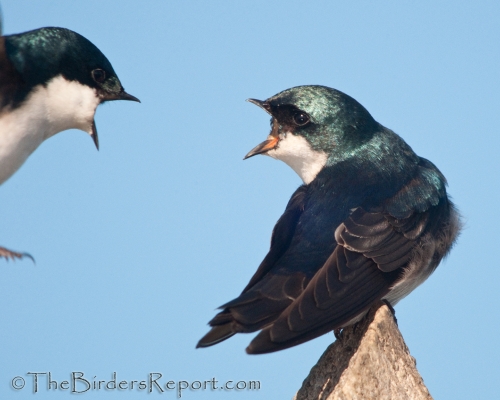
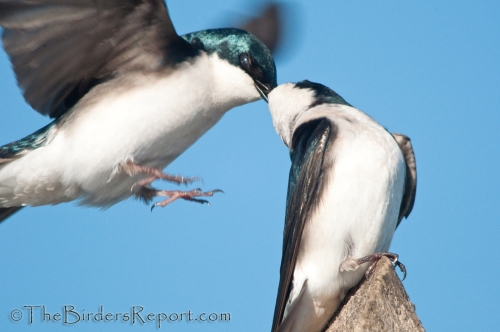
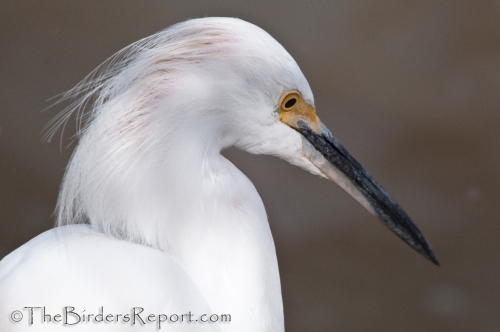
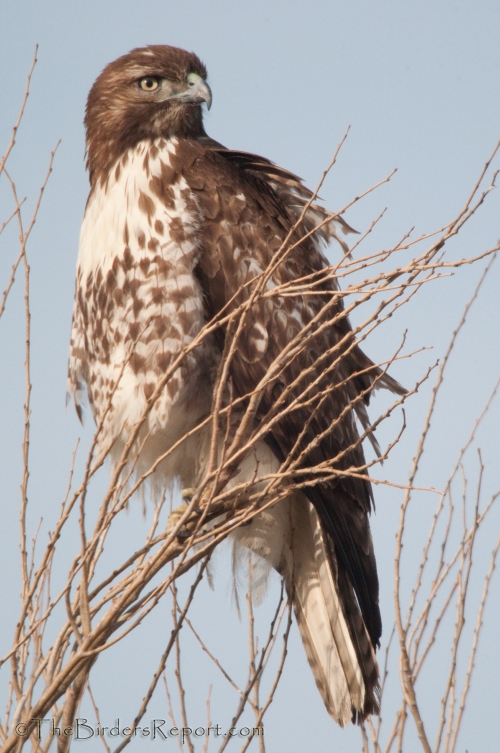
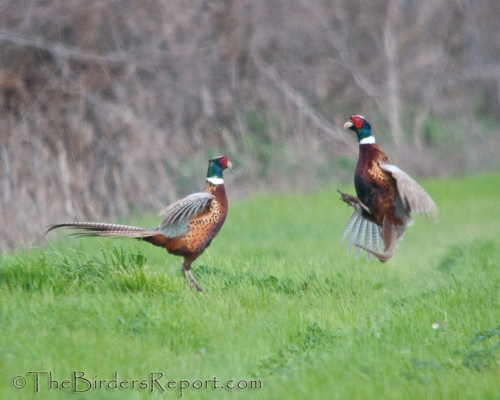








Comments on this entry are closed.
Wow! What a cool opportunity which resulted in some pretty amazing bird photos. Nice work Larry.
I could comment a lot here but, it is the tree swallows that really got my attention. What a nice situation. And you got it!
Love the image of the Pintail duck too and the geeze and…………. 🙂
Wow, those Ring-necked Pheasants are quite the show-stopper. Lovely collection Larry.
Man Larry! What a fantastic series. Looks like the blind was time well spent! That first Tree Swallow one is just awesome, what perfect timing. They’re all great!
The photos of the sunrise and the photo blind are beautiful! I couldn’t see the walk out to the blind – know it must be there somewhere!! Of course, the birds are fantastic. The dark morph of the Snow Goose is very interesting – I hadn’t heard about it before.
A great series of pictures Larry and of course most of those wildfowl are familiar to me but not in those numbers. We did have a single blue phase Snow Goose a couple of years ago that created a lot of interest but these attractive geese are kept in captivity so escapes can never be ruled out. Its very interesting that you “reserve” a hide, not a system we have over here. How does that work, and can you explain it more fully for us over here in one of your next posts?
What a series – just great! I think it’s great to be wrong in counting birds – that can only mean that there are lots 🙂
@Robert thanks. The wildlife refuges here do offer a lot of cool things for the public, the photo blinds are one of my favorite
@NF thank you very much. I’m glad you like them
@Gwen thanks. the Ring-necked Pheasants were quite the treat! I had never seen anything like it before
@Jill i love Swallows! Thanks!
@Mick the path to the blind is actually underwater. You have to wear waders to get out to it. The other blinds available are accessible just wearing boots
@Phil the blinds are offered on a first come, first serve basis beginning in October. You put in a request with your choices for three different weeks during the season and the four available blinds are divided up amongst the applicants. After the first group of requests are submitted, you get an email with the dates and blind you requested and dates not chosen are posted on the refuge’s website. At that point, you can request another date and blind that is still available. You pay a measly $15 for use of the blind for the day. You can review the process at their website here
@Natalie I never thought of it that way but you’re right, thanks 😉
Great set of photos! Love all the Snow Geese. As far as the Swallows go, it is hard to tell from a still photo, but it looks like the bird on the right is showing off its colors maybe?
A staggering number of fabulous birds here, Larry. Just wonderful. I’m getting and itchy twitchy shutter finger now! Great posts.
Hiya Larry,
What a generously elaborate post you have put up for us to enjoy.
I went to the blind link and was amazed at the sophistication of those hides. Looks cozy, built for two :-). Still, the can of wasp spray automatically supplied for each, worries me a little. Not only because it means that wasps are a given, but I wonder what the spray will do to those inside the blind. And don’t tell me it is harmless for humans. That ‘s what they said about DDT, which ruined my health.
Wow Larry that’s a grand series, and text. Boom & Gary of the Vermilon River, Canada.
So many wonders to see on your pst I don’t know where to start.
Firstly, I am a sucker for geese and then those incredible feeding shots of the swallows, WOW, followed by so much more and a pheasant cockfight in the wild!!
I am still breathless.
Just wonderful captures!!! 🙂
Great post Larry.
What a sight all those Snow Geese must have been.
Love the captures of the Tree Swallows, and the Snowy Egret.
Interesting to see birds that I know too; the Shoveler, Pintail and Gadwall.
A great post Larry so many beautiful birds to see. Thanks for sharing.
IM totally STUNNED–so many beautiful photos of some wonderful birdlife!! I think your guess is way off looks like 10,000 to me! The swallow photos are Brilliant..and I see my favorite Pintail the one Ive yet to see but have High hopes everytime I travel!
Beautiful pictures of the birds. We are waiting for the snow to melt a little so the snow geese can come in. I love to see the huge flocks visit the grain fields.
Stunning cast of birds, Larry! Every one is gorgeous. I love the colors and shapes of the Snow Goose on the water. Great Tree Swallow action scenes! I checked the BNA site for their specific behavior but couldn’t find anything either.
Splendid series of photos! What an experience to see all those Snow Geese massed together and I love the pose of the male Pintail. Wonderful captures of the juvie RTH and the Pheasants. And a great video of the Egret in action!
Larry, Thanks for taking us to this beautiful park. Right at the beginning you said,” they serve as resting and feeding areas for nearly half the migratory birds on the Pacific Flyway.” That is a staggering thought and you illustrate the point dramatically with picture after picture. My favorite is the pelican just because I’m a little crazy for them right now . It’s a pelican thing, you might not understand. However the tree swallows tell a wonderful story. This is one staggering post, been here 45 minutes!
Fantastic post and the photos are awesome. I lvoe the swallows and the pheasants are really cool. Great birds, Larry!
Amazing shots as always Larry and I think you are right that the Tree Swallow ‘food exchange’ behavior that you observed is probably related to pair bond formation or reinforcement.
Just when I think you have posted your best you go beyond the last one again. Splendid photos. The Tree Swallows are my favorites. Your video of the Egret catching fish was very cool. That creek looked like it was a rising and a raging!
Thanks for your kind comment on my blog. To answer your question: Yes…the front of the nestbox opens. It was built by a dear friend….so it is unique. “Wishing you Bluebirds!”:-)
@Mike yes I think the swallows are strengthening their pair bond for the upcoming breeding season
@Robin thanks. I always seem to have the itchy shutter finger 😉
@Joco the blinds are very nice. I know they have a can of wasp spray but I have never seen a wasp in any of the blinds! Maybe it depends on the season but I’ve never had a problem
@Gary, thanks!
@Arija thank you for your kind words and encouragement
@Tex thank you! I just came back from your blog and it is beautiful. Your Tufted Titmouse drawing is gorgeous!
@Keith thanks. I love the ducks
@Andrew thank you for stopping by with a comment
@Sondra thank you very much!
@Bill I hope you get plenty of Snow Geese!
@Hilke thanks. Maybe I should apply for a grant of some kind to study the swallow behavior?
@Pat thank you for your enthusiastic comment!
@Dave I’m glad you liked it! I am in awe of Pelicans myself. Very cool birds!
@Eileen thank you very much
@Chantelle I’m pretty sure you’re right about the swallow behavior, thank you
@Jean you are too kind. I hope you get lots of “blues” this season!
WOW… so many geese… we need some down here in the south!